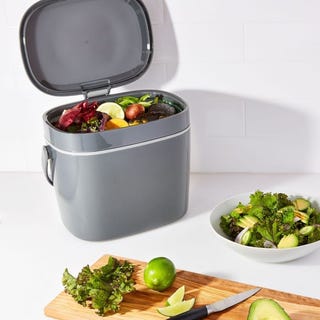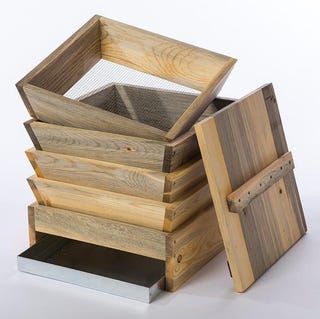Better Homes & Gardens Half-size Fabric Storage Bin
You might be used to tossing your food scraps in the garbage, but if you're worried about the environment and curious about composting, here's what you need to know. Composting puts your food waste to use instead of sending it straight to the landfills with your trash, which is important because when food scraps sit in landfills, they release methane, a greenhouse gas. And according to the United States Environmental Protection Agency, food scraps currently make up around 30 percent of what people throw away, when most of it could be composted instead.
When you compost your food scraps and other compostable waste, you not only reduce methane emissions and your carbon footprint, you also create a nutrient-filled substance that enriches soil, keeps your plants healthier, and reduces the need for chemical fertilizers. All-in-all, it's the greener way to go. And composting is a lot simpler than it seems.
How to Compost Indoors
No, you don't need a backyard in order to compost. For indoor composting, you've got a few options—you can collect scraps in a special compost bin that will allow waste to be broken down and turned into compost, or you can use a worm composter (AKA vermicomposting.) Composting with worms is basically the same concept, except rather than letting the scraps break down on their own, worms do the work for you and speed up the process. And in any case, with proper compost bins and care, you shouldn't have any issues with funky smells, not to mention bugs or other pests.
If you don't actually want to create your own compost but would prefer not to just toss compostable items in the trash, you can collect scraps in a bin and check with your city to see if there are local compost collection sites. (There are plenty of neighborhoods in New York City, for example, that have compost collection days on the sidewalk.)
In general, to compost, you need three basic things: What the EPA refers to as browns, greens, and water. Browns are things like twigs, dead leaves, and branches which provide carbon; greens are the food scraps you think of when you think of composting, among other compostable items, all of which provide nitrogen. And water is necessary as moisture is needed to break down all of the above into compost. You need equal parts browns and greens for proper composting.
What is Compost Tea?
According to The Old Farmer's Almanac, "compost tea" (no, you don't drink it!) is a liquid that is produced by extracting microbes from compost via a brewing process. This tea, like compost in general, helps boost plant health. Some indoor composting bins have spouts for draining compost tea, so keep that in mind while you're choosing the right bin for you.
Speaking of indoor compost bins, these options—both with and without worms—will get the job done indoors in the most stylish, mess-free way possible:

Bamboo Compost Bin
Bamboozle amazon.com
$44.99
The charcoal filter in this bin's vented lid means no weird odors will escape.

Good Grips Compost Bin
OXO bedbathandbeyond.com
$30.99
This composter has a handy lid that hides any overhang from your liner bag.

Polder Kitchen Composter
Container Store containerstore.com
$29.99
The flexible silicone bucket flips inside out for easy, no-touch emptying.

Mountable Easy-Fill Compost Bin
Joseph Joseph amazon.com
$19.99
Save counter space by mounting this bin to the inside of your cabinet door.

Wood & Stainless Compost Bin
World Market worldmarket.com
$29.99
Keep it sleek and smell-free with this wood bin with a stainless steel insert.

Living Composter
UncommonGoods uncommongoods.com
$199.00
This might be the sleekest worm composter to ever grace your counter.

Worm Farm Composter
Gardener's Supply gardeners.com
$179.00
Worms do their magic in the two middle trays, with a spigot for tea underneath.

4-Bin Worm Composter
SacredResource etsy.com
$188.00
This 4-bin worm option is perfect for a household of two to three people.
What Should You Compost?
If you've been considering composting, you probably already know the basics of what you can compost, like fruit and vegetable skins and scraps and coffee grounds. But, the list of things you can compost is actually much longer, and might even surprise you. You can also compost things like newspapers, cardboard, paper, pure cotton and wool fabric, wood chips, yard trimmings, hair, fur, houseplants, teabags, coffee filters, dryer and vacuum cleaner lint, and even fireplace ash. You can even compost your Christmas trees, if you have access to a wood chipper. And if you're ever unsure whether or not something can go in the bin, just do a quick search online. (Can I Compost This? is a pretty exhaustive resource, if you want to bookmark it.)
Just be sure not to compost any dairy products, eggs (the shells are good-to-go, though!), meat, fish, or fats and greases, as they can attract pests and cause odor issues. You also should avoid composting pet waste (due to risks like bacteria, parasites, and viruses), coal or charcoal ash, and any plants that have been treated with pesticides or had insect issues or diseases, as they can pass on these problems to your newly compost-fertilized garden.
You can read more about composting guidelines, backyard composting, and even how to create your own worm composting farm on the EPA website.
Follow House Beautiful on Instagram.
Brittney Morgan Market Editor, House Beautiful Brittney Morgan is a noted land mermaid and a Virgo with a penchant for crafts, red lipstick, and buying way too many throw pillows.
This content is created and maintained by a third party, and imported onto this page to help users provide their email addresses. You may be able to find more information about this and similar content at piano.io
Better Homes & Gardens Half-size Fabric Storage Bin
Source: https://www.housebeautiful.com/lifestyle/gardening/a28366427/how-to-compost-at-home/
Posted by: sansomcombehe.blogspot.com

0 Response to "Better Homes & Gardens Half-size Fabric Storage Bin"
Post a Comment